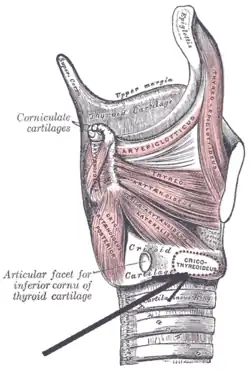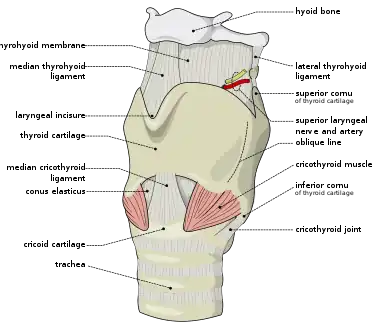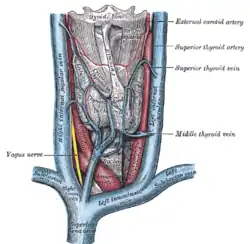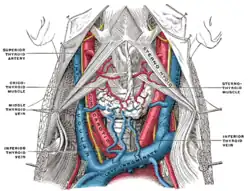Cricothyroid muscle
| Cricothyroid muscle | |
|---|---|
 Muscles of larynx. Side view. Right lamina of thyroid cartilage removed. | |
 The ligaments of the larynx. Antero-lateral view. | |
| Details | |
| Origin | Anterior and lateral cricoid cartilage |
| Insertion | Inferior cornu and lamina of the thyroid cartilage |
| Nerve | External branch of Superior laryngeal nerve (branch of the vagus nerve) |
| Actions | tension and elongation of the vocal folds |
| Identifiers | |
| Latin | Musculus cricothyroideus |
| TA98 | A06.2.08.001 |
| TA2 | 2193 |
| FMA | 46417 |
| Anatomical terms of muscle | |
The cricothyroid muscle is the only tensor muscle of the larynx aiding with phonation. It is innervated by the superior laryngeal nerve. Its action tilts the thyroid forward to help tense the vocal cords.
Structure
The cricothyroid muscle attaches to the anterolateral aspect of the cricoid cartilage and the inferior cornu and lower lamina of the thyroid cartilage.
Innervation
This muscle is the only laryngeal muscle innervated by the superior laryngeal branch of the vagus nerve known as the superior laryngeal nerve.[1][2]
Function
The cricothyroid muscle produces tension and elongation of the vocal cords.[1][3] They draw up the arch of the cricoid cartilage and tilt back the upper border of the cricoid cartilage lamina.[1][3] The distance between the vocal processes and the angle of the thyroid is increased, and the folds are consequently elongated, resulting in higher pitch phonation.[1] They work as antagonists to the posterior cricoarytenoid muscles.[4]
Clinical significance
The cricothyroid muscles may be injected with botulinum toxin whilst treating spasmodic dysphonia.[4] This is usually performed under guidance from electromyography.[4]
Additional images
 The veins of the thyroid gland.
The veins of the thyroid gland. The fascia and middle thyroid veins.
The fascia and middle thyroid veins. Side view of the larynx, showing muscular attachments.
Side view of the larynx, showing muscular attachments.
See also
- Cricothyroid ligament
- Larynx
- vocal fold
- Thyroid cartilage
- Vocology - science and practice of voice habilitation
- Adam's apple
- Phonation
- National Center for Voice and Speech
- Cricothyroid approximation
References
- 1 2 3 4 Duarte, Robert A.; Argoff, Charles E. (2009-01-01), Argoff, Charles E.; McCleane, Gary (eds.), "Chapter 19 - Glossopharyngeal and other Facial Neuralgias", Pain Management Secrets (Third Edition), Philadelphia: Mosby, pp. 116–118, ISBN 978-0-323-04019-8, retrieved 2021-01-12
- ↑ Kaplan, Edwin L.; Angelos, Peter; James, Benjamin C.; Nagar, Sapna; Grogan, Raymon H. (2016-01-01), Jameson, J. Larry; De Groot, Leslie J; de Kretser, David M.; Giudice, Linda C. (eds.), "Chapter 96 - Surgery of the Thyroid", Endocrinology: Adult and Pediatric (Seventh Edition), Philadelphia: W.B. Saunders, pp. 1666–1692.e4, doi:10.1016/b978-0-323-18907-1.00096-2, ISBN 978-0-323-18907-1, retrieved 2021-01-12
- 1 2 Berke, Gerald S.; Long, Jennifer L. (2010-01-01), Brudzynski, Stefan M. (ed.), "Chapter 10.1 - Functions of the larynx and production of sounds", Handbook of Behavioral Neuroscience, Handbook of Mammalian Vocalization, Elsevier, vol. 19, pp. 419–426, retrieved 2021-01-12
- 1 2 3 Bentivoglio, Anna Rita; Fasano, Alfonso; Albanese, Alberto (2009-01-01), Jankovic, Joseph; Albanese, Alberto; Atassi, M. Zouhair; Dolly, J. Oliver (eds.), "10 - Botulinum Neurotoxin in Tremors, Tics, Hemifacial Spasm, Spasmodic Dysphonia, and Stuttering", Botulinum Toxin, Philadelphia: W.B. Saunders, pp. 112–130, doi:10.1016/b978-1-4160-4928-9.00010-x, ISBN 978-1-4160-4928-9, retrieved 2021-01-12